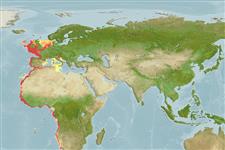Issue
Questionable synonym Arnoglossus blachei Stauch, 1965 is a valid species according to Fricke et al., 2023 (Ref. 128433). Pending correction in FishBase.
Environment: milieu / climate zone / depth range / distribution range
Ecologie
marien demersaal; diepte 20 - 350 m (Ref. 26999), usually 40 - 200 m (Ref. 36731). Subtropical; 58°N - 29°S, 19°W - 22°E
Eastern Atlantic: Scotland to Namibia (Ref. 27121), including the western Mediterranean.
Grootte / Gewicht / Leeftijd
Maturity: Lm ? range ? - ? cm
Max length : 25.0 cm TL mannelijk / geslacht onbekend; (Ref. 2683); common length : 12.0 cm TL mannelijk / geslacht onbekend; (Ref. 3397)
Dorsale stekels (totaal) : 0; Dorsale zachte stralen (totaal) : 95 - 106; Anale zachte stralen: 74 - 82. Eyes separated by a bony ridge, the lower eye a little in advance of the upper. In males, the second to sixth and in females, the second to fifth dorsal fin rays thickened and prolonged. Males with distinct black spot on posterior part of pelvic fins; in females, this spot present but greyish and often indistinct.
Found on sand, mud, shell and corals (Ref. 27121). Caught with bottom and pelagic trawls (Ref. 2683).
Levenscyclus en paargedrag
Maturiteit | Voortplanting | Paaien | Eieren | Fecunditeit | Larven
Aldebert, Y., M. Desoutter and J.-C. Quéro, 1990. Bothidae. p. 1027-1036. In J.C. Quero, J.C. Hureau, C. Karrer, A. Post and L. Saldanha (eds.) Check-list of the fishes of the eastern tropical Atlantic (CLOFETA). JNICT, Lisbon; SEI, Paris; and UNESCO, Paris. Vol. 2. (Ref. 5979)
Status op de Rode Lijst van het IUCN (Ref. 130435: Version 2024-2)
Gevaar voor de mens
Harmless
Gebruik door de mens
Visserij: commercieel
Tools
Speciale rapporten
Download XML
Internetbronnen
Estimates based on models
Preferred temperature (Ref.
123201): 9.8 - 19.2, mean 11.7 °C (based on 340 cells).
Fylogenetische diversiteitsindex (Ref.
82804): PD
50 = 0.5000 [Uniqueness, from 0.5 = low to 2.0 = high].
Bayesian length-weight: a=0.00589 (0.00391 - 0.00887), b=3.11 (2.99 - 3.23), in cm total length, based on LWR estimates for this species & Genus-body shape (Ref.
93245).
Trofisch niveau (Ref.
69278): 3.8 ±0.60 se; based on food items.
Weerstandsvermogen (Ref.
120179): Gemiddeld, minimale populatieverdubbelingstijd 1,4-4,4 jaar (Preliminary K or Fecundity.).
Fishing Vulnerability (Ref.
59153): Low vulnerability (15 of 100).
Nutrients (Ref.
124155): Calcium = 95.5 [46.4, 217.0] mg/100g; Iron = 1.01 [0.47, 1.79] mg/100g; Protein = 18.5 [17.0, 19.9] %; Omega3 = 0.327 [0.143, 0.642] g/100g; Selenium = 28.9 [15.2, 60.6] μg/100g; VitaminA = 20 [6, 62] μg/100g; Zinc = 0.785 [0.542, 1.118] mg/100g (wet weight);
